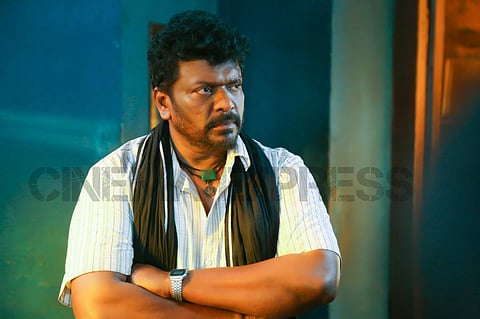Oththa Seruppu Size 7 Movie Review: An audacious experiment that works more than it doesn’t
Rating:(3.5 / 5)
Oththa Seruppu Size 7 is what Bryan Singer’s The Usual Suspects would have been, had the film been set in the detective office in which Kevin Spacey narrates his account, and of course, had the camera been trained only on him. In R Parthiban’s latest effort, the suspect is Masilamani (Parthiban), and the 120 minute-long film (which I understand has been cut by about 15 minutes since I caught it in advance) is his version of events, as he’s interrogated by two policemen. In a sense, you could argue that much like in that film, Masilamani is an unreliable narrator. He’s almost unhinged and keeps going off in tangents. It’s a film that has been—and will be—mainly talked about for its chief conceit of having only one cast member, and for being shot in a single room, but there’s more.
Director: R Parthiban
Cast: R Parthiban
This isn’t exactly shot with just a single person in a room. There are others around—a couple of policemen who seem adept at the good-cop bad-cop routine, a psychologist...—but you only hear these people. It’s admirable that you are still able to get a sense of who these people are. The voice cast is fairly elaborate. There are others whose voices join the party—like when Masilamani goes off on one of his reveries, on one of his flashbacks. You see only Masilamani throughout the film, and I know what you are thinking. It must take a fine actor to keep you intrigued for as long, right? Parthiban does it just fine. The script allows him to coast through a range of emotions—sometimes, he’s laughing but the tears are full of sadness. He is well-known for being skilled in wordplay too, and he channels quite a bit of that wit in this film. He plays around with words like ‘mop’ and ‘maapillai’, the multiple meanings of the word ‘manam’. While talking about mosquitoes, he uses the words, ‘All Out’ and ‘Good Night’, as effective threats. He may have let loose with the dialogue, but keeps the film song-free. The two or three that do get used are old Ilaiyaraaja songs and sound like they are being played on a radio. Masilamani is talking about an incident of lust, and you hear strains of ‘Ilamai enum poongatru’. Later, he’s talking about rural innocence, and need I say it, we hear, ‘Senthoora poove’.
As a director, he keeps changing things around to keep proceedings lively. One moment, he’s channelling Masilamani’s resentment for a cop. Another moment, he’s bringing in the good relations with the psychologist. He’s also using the flashbacks constantly to take your mind off the room and give you a breather. He also keeps Masilamani unpredictable in behaviour, and distracted in talk. It’s useful in ridding you of monotony but has the unfortunate side-effect of making the character a tad melodramatic.
It’s not just a film shot in a shabby room; it’s a film shot in a shabby room that is surprisingly aesthetic to behold (cinematography is by Ramji). Here too, there’s keenness to keep changing things around. They play around with day and night, with electricity and without. There are some inventive perspectives too. There’s a shot from behind a swinging pendulum. There’s one from above a fan. There’s one from above one of the two tube lights in the room. It’s fascinating how much you absorb, devoid of the distractions—visual and otherwise—of usual films. You notice that the room’s walls are in shades of cyan that keep changing. You notice that the room has a desk, three chairs, a bubble-top water can, a broken switchboard, an exhaust fan, a couple of windows, and quite notably, a large framed photograph of Gandhi. Every single one of these properties get utilised. Though all there is is a room—or perhaps because of it—Parthiban shows great resolve to make the most of every inch, every object. This includes even the sun, whose light streams in a beautiful yellow, offering the slightest hint of the freedom being enjoyed outside the room, the hope that Masilamani could have it.
The excellence in sound design (by Resul Pookutty) is to be heard to be believed. The claustrophobia of the room is again a blessing in disguise as it forces you to hear sounds you may not otherwise. There’s a joke about suppressed laughter and a dysfunctional tap that couldn’t work without the sound design. Every anecdote, every flashback of Masilamani’s comes alive with sound. The sound of blood gushing and a man choking, the sound of a man urinating on a wall… you hear all sorts of sounds vividly, and they evoke responses from you. There’s a scene that has Masilamani talking to a cop who, in turn, is talking to someone on the phone. It’s a fitting example of the sound work—pun intended—accomplished in this film.
All that is fine and dandy, but what about the story, you ask. While the how—in terms of structural integrity or the lack of it—is fairly enterprising, the what does not exactly blow you away. There’s a fair bit of repetition, and to spice things up, a couple of twists—of which one isn’t exactly sold well. In terms of the issues the film touches upon, they aren’t exactly revolutionary. Rural innocence, urban corruption, wealth and malice being friends, the impotence of the law… it’s all fairly standard. The treatment I cared a lot about, but the source on hand—despite an inspired twist—not particularly.
Nevertheless, this is a film I feel quite protective of. It’s great that this film got made. It’s great that leading technicians participated in it. It’s great that Parthiban’s constantly trying to evolve. It’s great that in a 30-year-old directorial career, his latest film is the best looking and the best sounding. It’s great that despite the enervating effects of time, he still cares.

